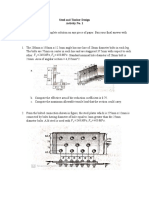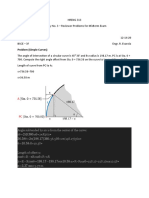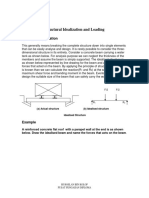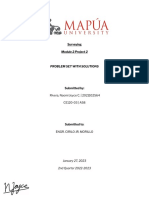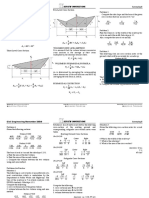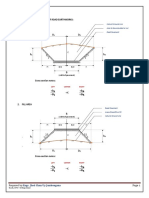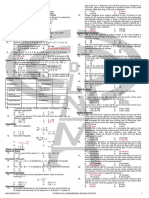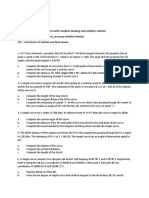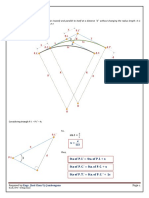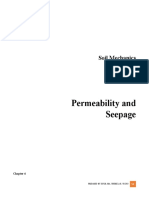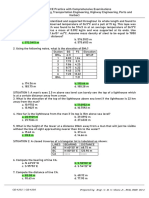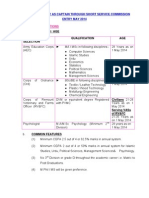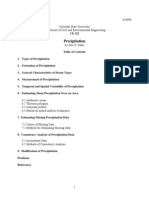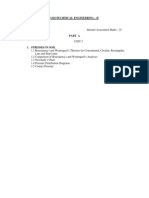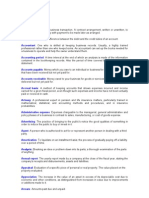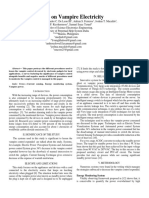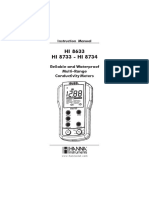PART V
SIMPLE CIRCULAR CURVES
Figure 1
Assume t h a t AV and VD are two straight portions o f a proposed highway and t h a t t h e curve BC i s t o be used a s a gradual change o f direction between them.
The curve has a constant radius R and i s called a simple c i r c u l a r curve.
The curve starts a t B and ends a t D
,'.
< A00 = < DCO =
9 0 '
P o i n t V i s referred t o as the vertex or Point o f Intersection ( P . I . ) .
�One of t h e values we must always know, or be a b l e t a determine, f o r any simple curve i s the d e f l e c t i o n angle a t the vertex. This angle i s designated by either I or A I n the case o f Figure 1, the survey i s assumed t o be progressing from A towards 0. I f this i s t h e case the d e f l e c t i o n angle a t the v e r t e x i s a s shown. 0 v
0
I n Figure 2 t h e quadrilateral BOCV has c e r t a i n qualities o f syrrnnetry,
fol 1 ows :
OB = <VBO =
<BVC =
as
OC because both are radii <VCO = 900 and, from t h i s 1800 - A and
A
<SOC
We can also say t h a t BV = VC. BV and VC are referred t o as t h e subtangent distances and are abbreviated S.T. or, q u i t e often, T.
Note a1 so t h a t , i f we join OV, we create two r i g h t - a n g l e d triangles, BOV and COV, t h a t are similar i n a l l respects. W e also apply names t o p o i n t B , where t h e curve begins, and p o i n t C, where t h e curve ends. W e have three choices and the v a r i o u s names are paired a s shown.
�B Name
Beginning o f Curve P o i n t o f Curvature Tangent-Curve Point
Abb.
B.C. P.C.
C Name
End o f Curve PointofTangency Curve-Tangen t P o i n t
Abb.
T. C .
E.C. P.T. C.T.
1.
Derivation of Formulae
0
I n A BOV
<VBO
9 0 '
BV -
BO
= =
Tan a
BV
BO
Tan
But BV = T and
BO = R
From t h i s
Figure 3
Referring t o Figure 4, on the f o l l o w i n g page, there are c e r t a i n dimensions associated w i t h a simple c i r c u l a r curve t h a t are important and we w i l l derive expressions for them t h a t relate them t o R or T.
�0 Figure 4
The s t r a i g h t l i n e BC i s called the Long Chord, abbreviated L.C.
In
A BEO, < BEO = go0
BE = I30
Sin A 2
or BE = BO Sin T
R
But BE =
L'C' and 00 = 2
The line EF i s called t h e Middle Ordinate, abbreviated M.O.
In
A BE0
and sector BFO
OE b u t Cos
A
M. 0 =
-OE OB
OF
OF
R and
=
7 but OB
�Substituti-ng the values of OF and OE i n the o r i g i n a l expression f o r t h e
M.O.
we get; M.O.
=
- R CDS
The expression, (1-Cos $) i s known as the Versine o f $ and t a b l e s g i v i n g values o f the Versine are publ~shed. This i s why we often see the above equation
i n the f o r m .
i s referred rnal and i s
Figure 5
In the right-triangle OBV and t h e Sector BFO
OV
- OF b u t
OV - Sec d - or 2 -
�OV =
OB Sec
R Sec
6 2
but 0 0 '
=
R R
so
OV =
Z. A also OF
The o r i g i n a l expression was;
OV
OF;
i f we make
the above s u t s t i t u t i o n s then
E =
R (set A
1)
------------------ ( a
T =
RTan$
F r o m E g u a t i o n (1);
R =
. -
or
Tan
-'
Substitute t h i s value o f R i n ( a ) above
Sec
A
T A --(Sec A Tan Z-
1)
A
E = T
Cos
1 Cos 2
,--S i nA2
Cos 2
Sin7
There i s an identity in trigonometry o f the form Tan
A =
1
1
COS A Sin A
I n the case o f ( b ) above i t would have the form
Tan 4 =
Sin
Cos 2A
From t h i s ;
�62
2.
Radius of C u r v a t u r e and Degree of Curve
There a r e three methods by means of which we can designate
t h e Hsharpnesstq of
curvature of a curve.
SHARP CURVE
FLAT CURVE
a)
Radius
The sharpness of c u r v a t u r e is i n v e r s e l y proportional to the
radius, ie. a reduction in r a d i u s increases t h e sharpness.
b)
Degree of Curve, chord d e f i n i t i o n
- Dc
Degree of curve according t o the chord definition, Dc, is
d e f i n e d as the angle subtended by a chord having a length of one
full s t a t i o n or 100 St. in the foot system and a 100 meters in
t h e metric system.
The radius of
This method i s followed i n railroad practice.
such a curve may be computed by t h e following
expression:
�Note t h a t t h e r a d i u s o f c u r v a t u r e varies i n v e r s e l y as the degree
o f c u r v e and t h e r a d i u s o f l o curve according t o t h e chord d e f i n i t i o n i s 5729.651 u n i t s o f measurements.
c ) Deqree o f Curve, arc d e f i n i t i o n
-D ,
The c u r v a t u r e i s expressed by s t a t i n g the "degree of curve"
Da
which has t r a d i t i o n a l l y been d e f i n e d as the angle subtended
a t the c e n t r e o f t h e curve by an a r c 100 f t . l o n g .
system, D , i s d e f i n e d as the a n g l e by a 100 m arc. a
I n t h e metric
S m a l l e r values of
D , decreases the sharpness o f c u r v a t u r e .
The arc d e f i n i t i o n f o r degree o f curve i s most frequently
followed i n highway p r a c t i c e .
When d e s i g n i n g a c u r v e , Da, is u s u a l l y selected on the b a s i s
of design speed, superel e v a t i o n and road surface f r i c t i o n factor.
Figure 7
I f a 100 f t or meter arc subtends an a n g l e o f l o , the r a d i u s
o f curve i s 5729.578 u n i t s .
W e refer to this as a "one degree
curve' .
�3.
Length o f Curve
a)
Lenqth o f Curve Chord D e f i n i t i o n
LC
The l e n g t h o f curve on the chord b a s i s , is t h e s u m a t i o n o f chords
which approximate the curve and, i s t h e r e f o r e , an i n e x a c t expression.
The LC obtained w i l l always be l e s s than the t r u e a r c l e n g t h .
d i f f e r e n c e w i 11 i n c r e a s e as
The
D , increases.
Where C
= 100,
A = Deflectoin angle o f curve
b)
Length o f Curve A r c D e f i n i t i o n
FIGURE 8
1 ,
The length o f curve or a r c l e n g t h f o r corresponding r a d i u s
varies d i r e c t l y t o t h e central angle subtended by the a r c .
Figure 7.
See
This
is an exact expression.
Note t h a t t h e length of curve ( o n t h e chords b a s i s ) L C , i s somewhat
less t h a n the a c t u a l a r c l e n g t h La.
as
T h i s difference w i l l increase
Da
or D
increases.
�65
The Arc Basis is Used
f o r t h e Calculations Presented in T h i s
Chanter.
Actually
both
chords
and
arc
methods
a r e used i n North
America.
For long gradual curves, which are commor! in railroad
practice, t h e chord basis (arc length considered to b e same as chords)
is
normally used.
For highway curves and c u r v e d p r o p e r t y
boundaries, t h e arc b a s i s is more common.
In f i e l d p r a c t i c e , field measurements of
t h e curve
are l a i d
o u t with t a p e , along the chord and not along t h e a r c , r e s u l t i n g
i n error.
T h i s error can be r e d u c e d when the a r c b a s i s is used
by using short a r c ( " c h o r d ' f ) length or applying t h e difference
between t h e arc length and t h e chord length.
For example, for a
100 meter 2'
10'
c u r v e , the chord length is 99.955 meters a n d for a
The
curve t h e chord l e n g t h i s 99.873 meters.
following
general rules a r e suggested in the m e t r i c system:
100 meter a r c s "chordsn up t o
30 meter a r c s +*chordsuup to 20 m e t e r arcs " c h o r d s " up to
10 meter
l o curves
curves
l o V curves 25
0
a r c s " c h o r d s w up to
curves
3 meter a r c s wchordslt Up t o 100' curves
4.
Example Problem f 1
THO tangents i n t e r s e c t a t Station 3
angle to t h e right is 4 0 ~ 0 0 ' 0 0 " .
highway
16.770.
The deflection
It is decided t o design t h e
90
for
maximum
speed
of
km/hr,
and
using
AASHO*
recommendation f o r superelevation and friction a mi nirnum r a d i a s
of 270 m e t e r s and a maxim~rn degree of curve, Da is to be 22'.
Calculate T, La, R and t h e stationing of t h e P.C.
20 meter a r c length.
a n d P.T.
using
American Association o f S t a t e Highway Organization
�Explanatlon
66
on a c u r v e we a r e g i v e n a specific
In t h e above problem, t h e
When we speak of a station
location from t h e s t a r t of t h e survey.
P.I.
is g i v e n as Stn. 3
16.770.
What we a r e saying is t h a t
P.1.
l a 316.770 m from t h e s t a r t of t h e survey.
T h e problem also s t a t e d that A is 40'
t o t h e r i g h t , t h i s says
t h a t when we stand at t h e P.C.
and l o o k in the direction in w h i c h
t h e survey is progressing, t h e curve deflects t o the r i g h t .
Solution
Given
P.I.
A
= Stn. 3
1
16.770
40
20 meter a r c
For safety Da may b e rounded down t o ZOO.
Using a r c definition
Recompute R a n d c a l c u l a t e T and La
R tan
- -286.479
2
tan
40 2
104.270
P.I.
Station 3
16.770
P.C.
S t a t i o n 2 + 12.500 La 2 + 00.000
P.T.
Station 4
12.500
�Figure 9
5.
Laying out a Curve by Deflection Angles
Curves are s t a k e d o u t usually b y the use of deflection angles
t u r n e d a t t h e P.C.
from the tangent to s t a t i o n s a l o n g the curve
together with the use of c h o r d s measured from station to s t a t i o n
along the curve.
I n the past 100 ft. chord l e n g t h c o u l d be l a i d out quite accurately, however,
in t h e metric system 100 meter chords w i l l
Most curves are presently laid out in
result in a large e r r o r .
20 meter chords or less and t h e discussion p r e s e n t e d here w i l l use 20 meter chord l e n g t h .
�68
First let us consider the first 20 m e t e r past the P.C.
N o t e that the a n g l e subtended by a 20 meter arc "chord" w i l l
be proportional to the degree of curve Da.
In isosceles A ,
<BAO =
= 90
AOB
<ABO
D/2
D/2
<VAB
Figure 10
To locate p o i n t B on the curve, we measure 20 m from the P.C.
W i t h t h e transit s e t up a t t h e P.C.,
and reading
when sighted
on the v e r t e x w e turn off an angle D/2 to align the tape and
e s t a b l i s h point B.
To locate point B on the curve, we measure 20 m f r o m the P . C .
w i t h t h e transit s e t up at t h e P.C.,
and reading 0
0
when sighted
on t h e vertex, we t u r n o f f an angle D/2 to align t h e tape and
e s t a b l i s h p o i n t B.
�Consider the second 20 metre chord BC
Measure 20 m from B t o C . J o i n AC. In isosceles t r i a n g l e OCA angle VAC = D. To locate p o i n t C measure 20 m from point B. With t h e transit a t the P.C., reading O0 on V, turn off angle D to a l i g n rape and e s t a b l i s h C.
FIGURE 11
FIGURE 12
�From:
Figure 10:
Note t h a t deflection a n g l e D/2 centre
1 / 2 a n g l e AOB a t
Figure 11: Note t h a t deflection angle D
centre
1/2 angle a t c e n t r e
Ffgure 12: Note that deflection angle 3D/2 = 1 / 2 a n g l e AOD a t
From t h i s we c a n
deduce a general r u l e .
If we s e t a t r a n s i t up a t e i t h e r t h e P.C.
or t h e P.T.,
and
s i g h t on t h e v e r t e x with t h e plates set at zero, we can turn t h e
correct a n g l e t o any p o i n t on a c u r v e of constant r a d i u s by
merely s e t t i n g on t h e p l a t e s a n angle e q u a l to half the angle a t
the c e n t r e s u b t e n d e d by t h e chord j o i n i n g t h e i n s t r u m e n t and t h e
desired point.
PC.
V= PI.
Figure 13
Figure of D e f l e c t i o n A n g l e s on a Simple Curve
O n the
above f i g u r e let p o i n t s a , b , c , d represent s t a t i o n
Point a is an odd distance from P.C. The deflection angles
p o i n t s on a simple curve.
and distance dB is also an odd increment.
are:
�U s u a l l y t h e P.C. and P.T.
d o n o t f a l l a t even s t a t i o n s but w e
are usually required t o p l a c e our stakes a t the even stations on t h e curve.
The first and l a s t odd length of arc or odd s t a t i o n ,
therefore, is u s u a l l y l e s s than 20 meters and the f i r s t and l a s t deflection angles are less than D/2.
In the case of an arc of a circle, the a n g l e subtended a t t h e
centre i s d i r e c t l y proportional t o the l e n g t h of t h e arc.
D a D
d
= = =
Angle subtended by a f u l l 100 meter station Angle subtended by a f u l l s t a t i o n (ie. may t o 100 or less) Angle subtended by an odd l e n g t h station
Length of arc of an odd s t a t i o n
S = Length
of arc of a f u l l s t a t i o n
C = Chord d i s t a n c e
The d e f l e c t i o n angle for an odd s t a t i o n = d/2
OR in more general form for an arc length, S
- -.
2
aD
D and d i n d e g r e e s
2 s
�The degree of curve, Da is defined f o r a 100 rn a r c l e n g t h ,
since we are using 20 rn a r c s arc is 1 / 5 of Da namely 4'.
the
a n g l e , D subtended by t h e 20 rn
The deflection angle, D/2 for a f u l l 20.000 m station is thus
2',
The distance from P.C.
to the f i r s t f u l l station is ( 2
20.000)
- (2
12.500
7.50 m ) ,
and t h e d i s t a n c e from the l a s t
full station on t h e c u r v e to P.T,
= 12.500 rn.
is ( 4
+ 12.500)
- (4
+ 00,000)
The deflection a n g l e s f o r t h e odd increments a t t h e beginning
and t h e end of t h e curve are:
*I =
0 '
45' ( a t beginning or curve)
2 = -
1'1 5 ' (at end
of c u r v e )
Chord distances for t h e i n i t i a l and f i n a l odd increments of arc and the full station are:
C1 = 2R S i n d , / Z
= 2 r 286.479
S i n 0.75'
S i n 1.25'=
7.500 meter
C2 = 2R S i n d 2 / 2 =
2 x 286.479
12.499meter
C20
= 2R S i n D l 2 = 2 x 286.479
S i n 2'
19.996 meters
It can be seen t h a t the chords l e n g t h are n e a r l y equal t o the a r c length and no correction would have to be a p p l i e d t o a c c o u n t
f o r t h e difference.
Let us now make up a s e t of field notes f o r t h e curve.
It
�73
should b e emphasized t h a t t h e form of field notes given is n o t
necessarily THE form of f i e l d notes though it s a t i s f i e s our needs
quite well.
T h e notes a r e s e t up on t h e assumption t h a t t h e transit is
s e t up a t t h e P.C,
' 0 00'
16.770).
00''
with
(Stn 2
+ 12.500)
and t h a t t h e plates read (Stn 3
+
the
i n s t r u m e n t sighted on t h e P.I.
T h e notes are designed to be absolutely complete s o t h a t t h e
man who is going to l a y o u t t h e curve d o e s n o t h a v e t o r e f e r t o
a n y o t h e r source f o r any information he may require with regard to t h e curve.
T h e bottom and t o p lines i n t h e notes relate our particular
c u r v e to the p r e c e d i n g and following c u r v e s .
The column headed "Bearingt' orients t h e c u r v e i n relation t o
t h e rest of t h e p r o j e c t as does t h e sketch.
�LOCATION OF SIMPLE CURVE
1
STAT ION
9 + 18.570
POINT
P. C.
DEFLECTION ANGLE
BRG
CURVE DATA
$25'18'~
4 + 12.500 4 + 00
3 + 80 3 + 60
P.T.
20~00 ' 00"
1a045 00"
= 6/2
A=
4 0 ' 0 0
' 00"
16'45 ' 00" 1445'00" 12'45 '00" 10'45' 00" 8'45
Da = 20'
3 + 40
La = 200.000
3 + 20
3 + 00
2 + 80
' 00"
'00"
T = 104.270
5 4 ' 6
+ 60
4O45 ' 00" 2'45
0'45
D/2 = 200100"
2 t 40
2 + 20 2 + 12.500
' 00" ' 00"
d1/2 = 0 ~ 4 5 ' 0 0 "
d2/2
115'00"
P.C.
oOOO ' 00"
0 + 11.380
P.T. LEFT HAND PAGE OF FIELD
BOOK
Figure 14 Note t h a t t h e s t a t i o n i n g increases from the bottom o f the page towards the t o p so t h a t the ins-trument-man, standfng a t P - C , and l o o k i n g a t t h e notes, sees t h e notes going away from him as does the curve.
�OAKHURST
L
ROAD
A-I2
PAGE 2 0
CLOUDY,2QC
ROHLFING,H
TRANSIT-SOKKISHA
30m.S T E E L TAPE N0.8
KOZ LOW, A STOf T, D
TAPE
ROD
P. 1 ,
I? c.
2+ 12.500
NORTH
RIGHT HAND PAGE
F i g u r e 15
Show :
Page No,
(The right-hand and left-hand page no.)
sheets have the same
Project
(If it is separate from t h a t on preceding and following pages)
Party; Date; Weather C o n d i t i o n s .
Sketch of curve (not necessary to scale)
Approximate o r i e n t a t i o n of curve (or correct values if known)
76.
He can check our curve by using latitudes and departures to
calculate t h e theoretical closing error a t t h e E.C.
i f a series
of chords are laid out from t h e B.C,
ASSUMED
NORTH
T=104.270
Figure 16 ( n o t t o scale)
�Traverse
Side
Function
Dist
Lat.
Dept
L'
EAST
ACTUAL E.C. IGNORING A N Y ERROR I N STAKING
3
m
beyond
The a c t u a l , s t a c k e d E.C.
0.012
{neglecting errors i n l a y o u t ) falls
rn outside t h e forward t a n g e n t and 0.035
the
theoretical E.C.
This error is n o t large and greater accuracy
would be aquired by having shorter chords lengths.
�78
6.
Intermediate Set-up f o r Simple Circular Curve
Sometimes,
because
of
the
length
of a c u r v e or because of
physical obstructions, t h e whole c u r v e cannot be r u n i n from e i t h e r
the P.C. o r t h e P.T.
If t h i s is the case it becomes necessary t o s e t
t h e t r a n s i t up at some station on t h e curve and to orient it in s u c h a way t h a t t h e f i e l d n o t e s can be used without modification
or f u r t h e r
calc~lation.
With
reference t o Figure 17 and u s i n g t h e f i e l d notes shown
p r e v i o u s l y we w i l l assume t h a t , w i t h t h e instrument s e t up a t the
P.C., we have
staked t h e curve t o Station 3 + 00.000 b u t
are ~ n a b l et o
+
see beyond t h a t p o i n t .
W e move t h e transit to Station 3
00.000.
Consider the curve AOB (Fig. 1 7 ) a3 being a complete c u r v e in
itself,
The c e n t r a l angle AOB
=
17~30~
Angle BAO = Angle ABO
Triangle
81 '1 5'
because
AV,B
is an isosecles d
3
the
two s u b t a n g e n t
distances (TI) * A V 1 and V,
Angle BAV,
=
are equal.
=
Angle V, BA
8'45'
W i t h t h e instrument s e t up a t B, with the p l a t e s clamped a t zero,
s i g h t back on A and clamp both motions.
Unclarnp t h e u p p e r motion and
t u r n a clockwise angle of 8'45'.
l i n e V BY
1 2
The line of s i g h t now lies along t h e
and is tangent t o t h e c u r v e a t B.
+
If B was t h e b e g i n n i n g
20 would be 2'00'
of a curve, t h e deflection a n g l e t o Stn 3
If we
plange t h e telescope we w i l l be sighting along t h e line BV
add 2'00"
and i f we
t o the 8'45'
already s e t on the p l a t e s we w i l l b e sighted on
Stn 3
+ 20 with
+
1 0 ~ 4 5 ' s e t o n t h e plates which is the v a l u e of the
20.
n o t e s f o r Stn 3
�79
Let us now assume t h a t we are a b l e t o s t a k e to Stn 3
+
80 but
cannot see beyond Point C.
We move our transit to Point C.
Let us c o n s i d e r curve BOC (Fig. 1 7 ) to be complete in itself.
Angle BOC
=
1 6 00'.
2
Angle OBC = Angle OCB = 82'00'
Triangle BV C is an isosceles triangle because the two subtangent
distances (T2) BV2 and V C are equal.
2
Angle V p B C = Angle V2CB
8 Y ~ ~ *
With t h e i n s t r u m e n t s e t up a t C, with t h e plates clamped a t
8'451,
sight back on B and clamp both motlona.
Unclarnp the upper
motion and turn the instrument c l o c k ~ i s ea n additional 8O00', so t h a t
t h e plates read 16'45'
and the line of s i g h t lies along t h e l i n e V CV
2
and is t a n g e n t t o t h e curve a t P o i n t C.
If C was the beginning of a
If we plange
curve t h e deflection a n g l e t o Stn 4
t h e telescope the l i n e
00 would b e 2000tt,
of sight will
be along the subtangent
CV
and
i f we add 2O00"
to t h e 16'45'
+
a l r e a d y s e t on t h e p l a t e s we w i l l be
s e t on t h e plates which is the value
sighted on Stn 4
00 with 18'45'
+
in the notes for S t n 4
00.
Again, we can proceed to s t a k e the next portion of the curve
without changing the field notes.
The t w o statements allow us to formulate a general rule for
intermediate setups on a simple circular curve.
When we occupy an intermediate s t a t i o n on a simple c f r c u l a r curve
and sight back on some previously established station, for t h e p u r p o s e of orienting the transit, the plates of the transit must be clamped at
t h e v a l u e of t h e deflection a n g l e
f o r t h e s t a t i o n being s i g h t e d on.
After Sacksighting and clamping t h e lower motion, i f we change t h e value of t h e angle on t h e plates t o t h a t f o r t h e d e f l e c t i o n a n g l e of
�80
the station that is occupied by the instrument, the line of sight will
be tangent to the curve and we can plunge t h e telescope and continue
staking the curve without making any change in the field notes.
Figure 17
Intermediate backsighting setup on a Simple Circular Curve
(not too scale)
�81
On Fig. 18 there is a s l i g h t l y different application of the r u l e .
In this case, the curve has been staked from t h e P.C.
to Stn 3 + 00
The
but the instrument is oriented by sighting ahead to t h e P.T.
p r i n c i p l e is the same as that o u t l i n e d above.
Figure 18,
Intermediate f o r e s i g h t i n g s e t up on a Simple C i r c u l a r
Curve (not too scale)
�82
The curve has been s t a k e d from A t o B and t h e instrument h a s been
s e t u p a t 8.
You will orient i t b y sighting ahead on the P.T.
He deduce
We will treat t h e s e c t o r BOC as an entity in itself.
t h e a n g l e BOC to be 22 30".
0
Angle OBC
Angle OCB
78 45'
In a B V , C , B V l = V I C
Angle V,BC
=
So A is
0
isosceles
Angle V I C B = 1 1 1 5 '
the
Following t h e rule s e t out on t h e previous example with
instrument s e t u p at B, s e t t h e deflection angle for C (20~00') on the
plates.
Sight on C and clamp the lower motion.
Unclamp the upper
motion and set the plates the deflection angle for point B.
Note t h a t 2g000'
a l o n g the line.
8'45'
= 11 ' 1 5 '
and t h e l i n e of sight now l i e s
BV
and we can continue staking without changing o u r
notes.
7.
F i e l d Procedure
a) S e t up a t P.I.
and l a y o u t tangents to establish P.C.
and
P. T.
b)
Set
up
at
P.C.
and
sight
back
to P . I .
Set
plates
to
OOOO'oO".
c)
Turn off f i r s t deflection a n g l e on transit and measwe out
the
first
subchord
distance,
pound
in
hub
and
write
stationing on it.
d)
Continue l a y i n g out chords and placing hubs.
When the last
�83
station
(P.T.
Is reached
the
last s u b c h o r d measured out
h u b establfshed earlier.
be
should be q u i t e close t o the P.T.
If i t is not, an e r r o r has been made and t h e curve h a s t o
r u n in a l l over again.
e)
It is advisable t o use intermediate s e t u p s when s e t t i n g out
the
curve.
They p r e v e n t communication d i f f i c u l t i e s and tend
t o reduce t h e number of
errors.
�PROBLEMS
1.
Calculate the radius of the curve t h a t w i l l pass through Point P , using 1a t itudes and departures. Determine the stationing o f t h e P.C. and P , T , and o f Point P on the curve.
2.
Solve for l e n g t h o f the curve i n t e r s e c t i o n distance AB, based on t h e fo1 lowing diagram.
�3.
Calculate BC, area ABC (shaded) and angle d :
RADIUS
391.10 rn
